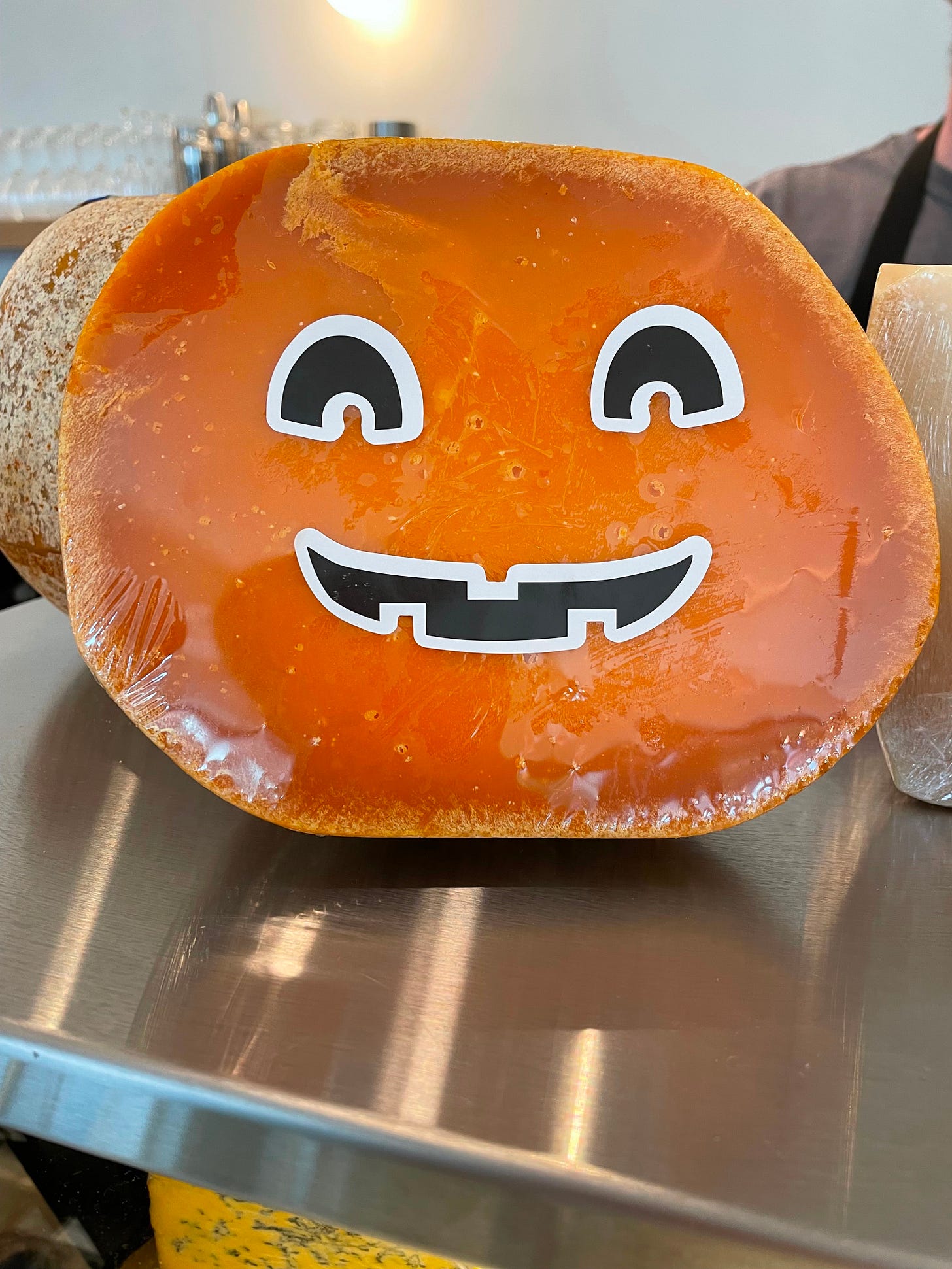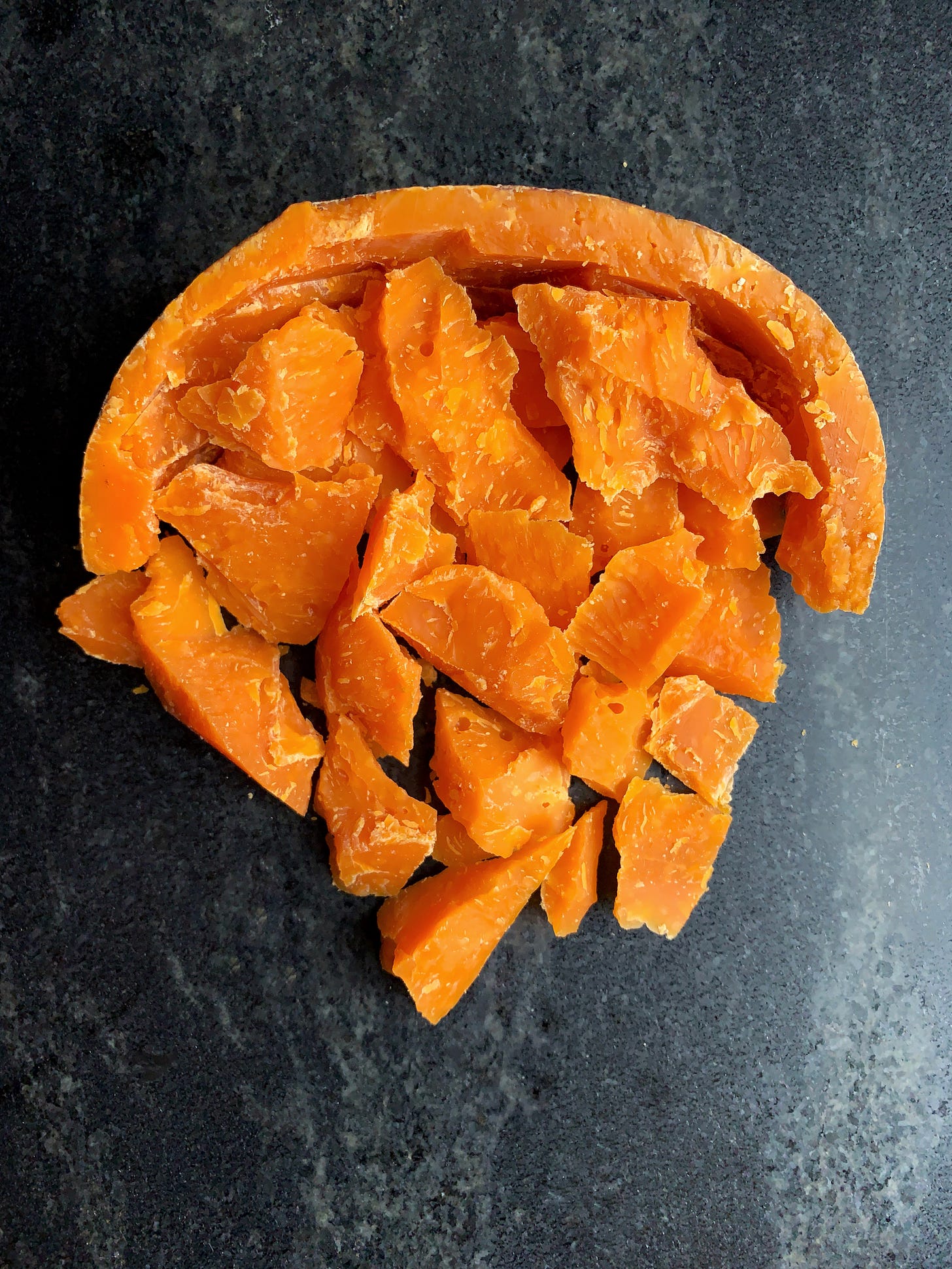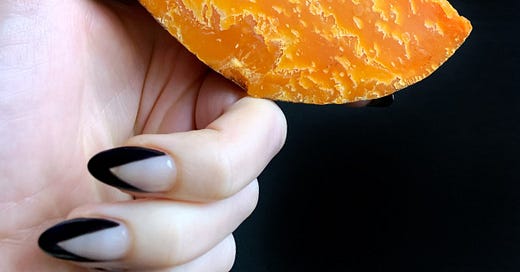Hello congregants!
Welcome to spooky season! Here in Chicago, the temperature has dipped into the sixties, the sky is gray with a moody overcast, and the maples are tinged red at their crown. Fall has officially arrived, and I am tired. The urge to hibernate is hitting me hard, but I‘m too busy tying up all the loose ends before I leave for vacation next week. I‘m heading down to Oaxaca and Mexico City to feast on squash blossom quesadillas filled with milky, melty Quesillo, slabs of grilled pañela nestled onto warm tortillas, and hunks of buttery Cotija Añejo. I’ll give you a little trip recap in the next bulletin, but for now let‘s talk about a cheese that should definitely be on all of your Halloween cheese boards: French Mimolette.

Cheese of the Month: Mimolette
There is no cheese more fitting for an October feature than French Mimolette. Glowing pumpkin orange with a cratered, moonlike exterior, she’s one of the most unique and iconic cheeses that actually started as a knock-off. Way back in the seventeenth century, the French went to war with the Netherlands and stopped all trade between the countries. France was so bereaved over the loss of Edam, that the prime minister commissioned cheesemakers to create a replacement for the Dutch cheese with a distinguishing bright hue. And just like that, Mimolette was born.
Though she’s originally from Lille, most of the Mimolette we get in the states comes from Normandy. She’s what’s known as a washed curd cheese, which means the curds are rinsed with water to remove some of the lactose and stunt the production of lactic acid, resulting in a sweeter cheese. Her striking orange hue comes from annatto, a potent seed-based dye that doesn’t have much of an effect on the flavor.

Mimolette has a similar flavor profile to other washed curd cheeses, such as Gouda or Edam. I find her a bit more salty, probably because the wheels are brined for 3 days. After taking their salty little baths, the wheels are tucked tightly onto wooden boards for their initial aging stint, then transfered to nets for the spookiest step in the process: the cheese mites. These tiny spidery creatures live to gorge themselves on the surface molds, leaving a cratered terrain on the rind and helping to develop a nutty, floral flavor.
I know that sounds super freaky, but cheese mites are quite common in cheesemaking. The French call them petits affineurs, and they’re essential to the Mimolette make process. For most cheesemakers, however, they’re a nuisance that must be vacuumed off. If left unchecked, they can dig into the paste, letting in unwanted molds that can change the flavor, aroma, texture, and appearance of a cheese. They’re too small to see with the naked eye, but they mark their presence by leaving a dusty residue around the wheels—a mixture of mite corpses and excrement.
The flavor of Mimolette evolves similarly to a Gouda: she’s mild and buttery when young, but overtime she develops notes of butterscotch and a toasty tang reminiscent of Cheez-Its. Her texture also evolves, transforming from smooth and pliable into flakey and crystal-flecked. I think she shines best with sweet accompaniments, like apples, candied nuts, and candy corn. I know that last one sounds weird, but they complement each other’s honey sweet flavor and toothsome, waxy texture (shoutout to Michelle Viera for discovering that epic pairing).
Let me know how you’d pair Mimolette in the comments below!
How to Serve: cut the top and bottom rind off the wedge, then thinly slice into triangular slices.
Sweet Pairings: pistachio butter, green apples, fig jam, candied pecans, buckwheat honey, candy corn
Savory Pairings: country pate, prosciutto, caramelized onions, fried sage
What to Drink: coffee, stout, cider, bourbon, a hot toddy
Where to buy: she‘s pretty availably at specialty shops and even supermarkets like Whole Foods and Kroger. Find a local cheese shop near you or checkout my online retailer list.
Tip of the Month: Always bring cheese to room temperature before eating it.
Refrigeration dulls the flavor and makes the texture brittle, which means you’re missing out on the nuances that the cheesemaker worked so hard to produce. Temper soft cheeses for at least twenty minutes and firmer ones for about forty minutes.
Charity of the Month: UNRWA USA
Each month I donate proceeds from my Cheese Angel pin to a different charity. This month's featured charity is UNRWA USA, a nonprofit organization that lifts up the voices, experiences, and humanity of Palestine refugees to secure American support for resources essential to every human beings, for the promise of a better life. Shop the pin or donate directly.
Thanks for for being here. May Cheesus bless you all!
🖤 Erika









Thanks for the post! Mimolette is such a more-ish cheese, almost addictive.
One of my very favorite cheeses! Great pairing ideas. Seems like I need to go to the store!